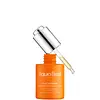What's inside
What's inside
 Key Ingredients
Key Ingredients

 Benefits
Benefits

 Concerns
Concerns

 Ingredients Side-by-side
Ingredients Side-by-side

Propanediol
SolventAscorbic Acid
AntioxidantDimethyl Isosorbide
SolventAlcohol Denat.
AntimicrobialPEG-12 Dimethicone
Skin ConditioningCarnosine
Skin ConditioningAlpha-Arbutin
AntioxidantSalicylic Acid
MaskingCurcuma Longa Root Extract
MaskingPinus Pinaster Bark/Bud Extract
AntimicrobialDiglycerin
HumectantParfum
MaskingLimonene
PerfumingLinalool
PerfumingAmyl Cinnamal
PerfumingHexyl Cinnamal
PerfumingAlpha-Isomethyl Ionone
PerfumingCitral
PerfumingCI 19140
Cosmetic ColorantCI 14700
Cosmetic ColorantPropanediol, Ascorbic Acid, Dimethyl Isosorbide, Alcohol Denat., PEG-12 Dimethicone, Carnosine, Alpha-Arbutin, Salicylic Acid, Curcuma Longa Root Extract, Pinus Pinaster Bark/Bud Extract, Diglycerin, Parfum, Limonene, Linalool, Amyl Cinnamal, Hexyl Cinnamal, Alpha-Isomethyl Ionone, Citral, CI 19140, CI 14700
 Reviews
Reviews

Ingredients Explained
These ingredients are found in both products.
Ingredients higher up in an ingredient list are typically present in a larger amount.
Ascorbic Acid is is pure Vitamin C. This form makes up the largest amount of vitamin C found naturally in our skin.
Not only is vitamin C great for your overall health and immune system, it also has plenty of benefits on your skin.
Vitamin C is best used for brightening skin. It improves dark spots, acne scars, and hyperpigmentation. This is because it blocks the process of skin darkening when exposed to UV.
Remember: Vitamin C should not replace sunscreen!
Your skin uses vitamin C to build collagen. Collagen is one key component in having a strong skin barrier and plump skin. Vitamin C also plays a role in regulating collagen, thus making it effective in improving wrinkles and fine lines.
Ascorbic acid shows potent antioxidant activity. As an antioxidant, it helps fight free-radicals. Free-radicals are molecules that may damage your skin cells. These antioxidants also protect skin against UV damage.
The best formulations include Vitamin E and/or ferulic acid. These two ingredients help stabilize and provide a boost in the benefits of ascorbic acid. This is because ascorbic acid becomes unstable when exposed to UV and air. In fact, you can tell your ascorbic acid has oxidized when it turns an orange-yellow color.
Ascorbic acid is generally compatible with other ingredients. However, using ascorbic acid with other active ingredients might cause irritation. Two ingredients: copper ions and benzoyl peroxide, will inactivate ascorbic acid completely.
Read more about other types of Vitamin C:
Foods rich with vitamin C include oranges, strawberries, broccoli, bell peppers, and more. When consuming Vitamin C, your skin receives a portion of the nutrients.
Learn more about Ascorbic Acid